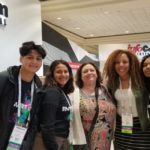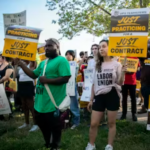Update: Acclaimed Emmy Award winning filmmaker Ken Burns joined by Harvard Professor Henry Louis Gates Jr., will talk about race in America at a National Press Club luncheon March 14.
By Alyssa Rosenberg
Act Four, Opinion, The Washington Post, 12/10/15 —

People walk past Emanuel African Methodist Episcopal Church in July in downtown Charleston, S.C. (John Moore/Getty Images)
Alyssa Rosenberg blogs about pop culture for The Washington Post’s Opinions section.
The idea of a conversation about race that will miraculously break a longstanding American deadlock may be a bit of a canard, but it’s a persistent one. And on Wednesday morning, I went to the office of Mayor Joe Riley in Charleston, S.C., to ask documentarian Ken Burns and Harvard professor Henry Louis Gates Jr. how their new lecture series might differ from previous entrants in the genre.
Burns, inspired by the mass shooting at Emanuel African Methodist Episcopal Church earlier this year, had reached out to Gates to ask whether he would join in a series of conversations. And after conversations with Riley, who leaves office in January after 40 years on the job, the two men agreed to begin the series in Charleston, which was once one of the most significant ports in the American slave trade, to help Riley raise money for his planned International African American Museum. Burns and Gates will continue the series at SXSW in Austin, Brooklyn and in Washington in 2016.
“We live in a superficial media culture,” Burns said, suggesting that sustained conversation would function differently. “And so the idea of a conversation migrating to anything less than just kicking a can down the road seems sort of impossible. You just can’t be distracted by that. We’ve had this extraordinary tragedy happen here in this town. There was an immediate and beneficial consequence out of the lives that were sacrificed, but then nothing happened … You want to figure out a way in which you can acknowledge the huge advances that those symbolic changes — the removal of the Confederate flag — mean for the citizens not only of South Carolina but of the United States, but you’ve got to keep talking about it. The problem is that we never do. We let it go. We think that we’ve got a moment, a teachable moment, but really what it is is just a media moment. And then the attention is distracted somewhere else. This is about saying we really do believe this.”
And Gates suggested that he wanted to find a way to move away from the established contours of the so-called conversation about race.
“My subject position, as it were, allows me to bring another level of analysis to the conversation. And that is the story of race within race,” Gates told me. “No longer, 50 years after Martin Luther King died, can we say that there are two Americas — one black, one white. That’s ridiculous. That’s a stereotype. But we really have two nations within the African American community” because of widening income inequality between African Americans themselves as some black people “achieve what my mama used to call white money, rather than colored money.”
“Until we begin to realize that there are different kinds of black America, then I don’t think that we will be able to bring an analysis as sophisticated as the one Ken called for and articulated so beautifully to a problem that is much more complex now than simply black or white,” Gates continued. “It does my heart good to see the Black Lives Matter organizers, the three women who organized it, [and] DeRay Mckesson, to see them who are so well-educated, so articulate, reaching back and saying no, we want to shut this down until more black people move from the no-class to the working class” in keeping with W.E.B. Du Bois’s call for upwardly-mobile African Americans to take responsibility for the poor.
And Burns suggested that a genuine conversation animated by common interest could avoid the pitfalls of the way such conversations are often framed as debates that require the listener to choose from opposing sides.
“You’ve got an opportunity to sort of rearrange the molecules of people’s perception and perhaps ease up those things that have become frozen. We are all so dialectially preoccupied that any kind of argument just kind of goes to a binary response, either it’s positive or negative,” Burns said. Through art and history, “you have the possibility of relaxing, if not dissolving, the sort of initial, knee-jerk, binary response. If you can do that, then all of a sudden you’ve said, ‘I don’t want you out of this conversation, I don’t want to take away your history by including this, I think we’re big enough to include something else.’ ”
Gates pointed out that he tries to teach students that the debates they’re having are not new: One unit in his lecture course focuses on debates over what African Americans should be called that took place in William Lloyd Garrison’s abolitionist publication, the Liberator, and black newspapers between 1831 and 1845.
So, did Burns and Gates hit the marks they set for themselves?
Both Burns and Gates have new documentaries forthcoming on PBS, and a substantial part of the program was given over to clips from “Jackie Robinson,” which premieres in April, and “And Still I Rise: Black America Since MLK,” Gates’s new film, which arrives in the fall. (When technical issues caused a long pause between clips, a “Black Lives Matter” chant rose from the back of the auditorium.) And the evening included remarks from Riley about the museum.
Balancing these purposes meant that the time for actual conversation was limited to a half-hour. But while future dates might benefit from a greater focus on discussion, those 30 minutes were still enough for Burns and Gates to develop a few early themes.
Gates emphasized the power of images, drawing a line from the lynching postcards of the 20th century to the Jim Crow Museum‘s collection of racist depictions of President Obama to Spike Lee’s recent remarks about the exclusion of African Americans from decision-making roles in Hollywood. And he drilled down hard on economic issues, suggesting that “racism is ultimately a function of economics,” and that anti-Semitism and anti-black racism always spike in times of broader economic crisis.
“Now, affirmative action is the way we perpetuate our class status within the race,” Gates said, remarking on the programs that helped him and other black students integrate historically white elite colleges, but that he suggested have become a way to aggregate advantages for wealthier students of color. “I think we need affirmative action, but I think we need affirmative action in this country for poor people.”
And Burns, who said that the shootings at Emanuel “rocked me to my core,” emphasized the need for continued engagement after the mourning and catharsis that follows such shocking incidents of racism.
“What I want so desperately is to find meaning in the loss of nine lives … We tend to just forget … We feel impotent in a way,” Burns acknowledged. “We all want to know what the blueprint is to move forward. And the blueprint’s not very clear.”
Gates has helped set up a scholarship fund named for the Rev. Clemnta Pinckney,who was killed at Emanuel and who Gates interviewed for a previous documentary, and apologized, suggesting of the $3.5 million given by anonymous donors that “it’s not enough. … But it’s a small contribution to easing the pain.”
The path forward that Burns, Gates and Riley chose to point to on this December evening was a narrow one, but the small road may have yielded the most important insight.
“I have done nothing in this and for this city at all, not one single thing, alone. The achievements that we celebrate together are the achievements of this remarkable community,” Riley said. “We have before us the most important achievement: the International African American Museum, for here in this institution, we will be giving something to our country, not just to ourselves, but to our country. And what we give to America is something that it has desperately needed because it’s been missing. And that is that we help write the complete history, the complete history book of America. We fill in the blank pages in the volume of history. We fill them in. It’s the history of African Americans. For we can’t understand who we are as a people if we don’t understand the history of Africans who were brought here against their will and the contribution we made to our country.”
Riley’s remarks, coming on the 40th anniversary of the night he was first elected mayor of Charleston in 1975, may have come been a fundraising appeal. But they were also a valuable bit of conversational framing, suggesting that an honest reckoning with the most difficult aspects of American history were not an act of theatrical guilt or self-abnegation, but a gift to the country — and to future generations who might be spared the burden of hate through a greater knowledge of all the ways that Africans and African Americans were indispensable to what’s best and most beautiful in Charleston and all across America.











